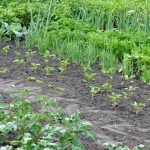Ancient manual of Chinese vegetable gardening has been a valuable source of knowledge and wisdom for centuries. The history and origin of this manual dates back to ancient times, offering key principles and techniques that have stood the test of time. Chinese vegetable gardening holds great cultural significance and traditions, which continue to influence modern-day applications.
The Ancient Manual of Chinese Vegetable Gardening provides insight into the rich history and origins of traditional Chinese horticulture. The manual outlines key principles and techniques that have been passed down through generations, offering invaluable guidance for cultivating a wide variety of vegetables and plants. Understanding the importance of Chinese vegetable gardening in ancient times is essential for appreciating its lasting impact on modern agricultural practices.
In addition to providing practical guidance for cultivating various vegetables, the ancient manual also highlights the cultural significance and traditions surrounding Chinese vegetable gardening. This timeless wisdom continues to inspire and guide individuals seeking to implement these age-old practices in their own gardens. With an emphasis on sustainability and self-sufficiency, the ancient manual offers tips and tricks for those looking to incorporate Chinese vegetable gardening into their own gardening endeavors.
The History and Origin of the Ancient Manual of Chinese Vegetable Gardening
Historical Significance
The “Qimin Yaoshu” is considered one of the oldest existing texts on agriculture in China and offers a fascinating glimpse into the agricultural practices of ancient China. It covers a wide range of topics related to farming, including crop cultivation, soil management, irrigation techniques, and pest control. The manual also emphasizes the importance of sustainable and harmonious co-existence with nature, reflecting the ancient Chinese philosophy that underpins traditional agricultural practices.
Transmission and Influence
Over time, the knowledge contained in the ancient manual of Chinese vegetable gardening spread across various regions and significantly impacted agricultural practices in East Asia. The principles and techniques outlined in the manual continue to be cherished and applied by modern-day farmers seeking to uphold traditional methods while adapting to contemporary agricultural challenges. The enduring influence of this ancient text underscores its invaluable contributions to sustainable and eco-friendly farming practices.
Preservation Efforts
In recognition of its historical significance, efforts have been made to preserve and promote the “Qimin Yaoshu” as a cultural treasure. Its inclusion in UNESCO’s Memory of the World Register highlights its status as a priceless heritage that offers timeless wisdom for sustainable agriculture. Scholars continue to study this ancient manual to gain insights into traditional Chinese agricultural knowledge and contribute to ongoing efforts for preserving this vital aspect of China’s cultural heritage.
Overall, understanding the history and origins of the ancient manual of Chinese vegetable gardening provides valuable context for appreciating its enduring legacy as an invaluable resource for sustainable farming practices rooted in centuries-old wisdom.
Key Principles and Techniques From the Ancient Manual
The ancient manual of Chinese vegetable gardening is a valuable source of knowledge that provides key principles and techniques for successful gardening. This manual, which dates back centuries, offers timeless wisdom that continues to be relevant in modern times.
One of the key principles outlined in the ancient manual is the importance of maintaining a harmonious balance with nature. This includes understanding the natural elements, such as soil quality, sunlight, and water, and working in alignment with them to achieve optimal results.
Another fundamental technique emphasized in the ancient manual is the practice of crop rotation. This technique involves systematically changing the location of plants within a garden to promote soil fertility and reduce the risk of disease. The ancient manual also provides detailed instructions on proper planting methods, including spacing, depth, and timing for different types of vegetables. Additionally, it offers guidance on natural pest control and organic fertilization methods based on traditional Chinese agricultural practices.
The ancient manual of Chinese vegetable gardening holds cultural significance as it reflects the deep connection between people and their natural environment. It promotes sustainable farming practices that have been passed down through generations, embodying a holistic approach to gardening that considers both environmental and human well-being.
| Ancient Principles | Techniques |
|---|---|
| Maintaining harmony with nature | Crop rotation method |
| Cultural significance | Natural pest control techniques |
The Importance of Chinese Vegetable Gardening in Ancient Times
Chinese vegetable gardening has played a vital role in the lives of ancient Chinese people. The cultivation of vegetables was not only for sustenance but also deeply rooted in their cultural and spiritual beliefs. The principles and techniques outlined in the ancient manual of Chinese vegetable gardening were highly regarded and followed with great reverence.
The importance of Chinese vegetable gardening in ancient times can be attributed to the fact that it provided a sustainable source of nutrition for the people. With an emphasis on cultivating a wide variety of vegetables, including leafy greens, root vegetables, and edible flowers, the ancient Chinese were able to maintain a well-balanced diet. This ensured that they had access to essential nutrients necessary for their overall health and well-being.
Moreover, Chinese vegetable gardening held immense significance in traditional Chinese medicine. Many of the plants and herbs grown in ancient Chinese gardens were used for their medicinal properties. The practice of using vegetables and plants as remedies for various ailments dates back to ancient times, as documented in the ancient manual of Chinese vegetable gardening. This demonstrates that the art of cultivating vegetables was not only practical but also deeply intertwined with their holistic approach to healthcare.
| Importance | Ancient Times |
|---|---|
| Sustainable nutrition | Cultural & spiritual beliefs |
| Ties to traditional Chinese medicine | Medicinal properties |
Notable Vegetables and Plants in Chinese Vegetable Gardening
Chinese vegetable gardening has a rich tradition of cultivating a wide variety of vegetables and plants that have been cherished for centuries. The ancient manual of Chinese vegetable gardening provides valuable insights into the cultivation and care of these notable vegetables and plants, many of which have become staples in Chinese cuisine. Here are some of the most notable vegetables and plants that have been cultivated through the ages:
- Chinese Cabbage (Napa Cabbage): This leafy green vegetable is a popular ingredient in many Chinese dishes, valued for its tender texture and mild flavor. It is often used in stir-fries, soups, and pickled preparations.
- Chinese Broccoli (Gai Lan): Known for its thick stalks and dark green leaves, Chinese broccoli is a versatile vegetable that can be steamed, stir-fried, or blanched. It has a slightly bitter taste that pairs well with savory sauces.
- Bok Choy: Also known as Pak Choi, this leafy green vegetable is commonly used in both stir-fries and soups. Its mild flavor and crisp texture make it a favorite among Chinese home cooks.
In addition to these leafy greens, Chinese vegetable gardening also includes a variety of herbs, fruits, and root vegetables that hold cultural significance. For example:
- Garlic Chives: These aromatic herbs are often used as a garnish or seasoning in many Chinese dishes. They add a subtle hint of garlic flavor to various culinary creations.
- Lotus Root: This underwater rhizome has a crunchy texture when eaten raw, but becomes tender when cooked. It is often used in soups and stews for its unique taste and texture.
- Chinese Long Beans: These long, slender beans are commonly seen in Asian markets and are frequently used in stir-fries due to their distinctive flavor and meaty texture.
The cultivation of these notable vegetables and plants from the ancient manual not only adds diversity to one’s garden but also connects individuals to the rich heritage of Chinese horticulture. Their presence reflects the timeless wisdom found within the pages of this ancient manual.
Modern-Day Applications of the Ancient Manual of Chinese Vegetable Gardening
The ancient manual of Chinese vegetable gardening may have been written centuries ago, but its principles and techniques continue to be relevant in modern-day gardening. With the increasing interest in sustainable and organic practices, many gardeners are turning to traditional methods like those found in the ancient manual for guidance.
Organic Gardening
One of the key principles from the ancient manual is the emphasis on natural and organic gardening practices. This includes using natural fertilizers, companion planting, and crop rotation to maintain soil fertility and prevent pest infestations. These methods align with modern-day organic gardening principles, making the ancient manual a valuable resource for those seeking to minimize their environmental impact.
Companion Planting
The concept of companion planting, as outlined in the ancient manual, is also being embraced by modern gardeners. By planting certain vegetables together, gardeners can promote growth, repel pests, and improve flavor. This traditional technique has proven to be effective in modern times as well, leading many to adopt the companion planting methods described in the ancient manual.
Sustainable Practices
The ancient manual also emphasizes sustainable practices such as water conservation and soil management. These practices are particularly important in today’s world, where climate change and environmental degradation are major concerns. By following the principles laid out in the ancient manual, modern gardeners can contribute to a more sustainable future while still enjoying an abundant harvest.
As more people seek alternative approaches to gardening that prioritize sustainability and self-sufficiency, the wisdom found in the ancient manual of Chinese vegetable gardening continues to be valued and applied in today’s gardens.
Cultural Significance and Traditions Surrounding Chinese Vegetable Gardening
Chinese vegetable gardening holds a special place in Chinese culture, with deep-rooted traditions and significance. The practice of vegetable gardening has been an integral part of Chinese culture for centuries, with the ancient manual of Chinese vegetable gardening serving as a guide for generations. This ancient manual is a testament to the rich history and traditions surrounding Chinese vegetable gardening, offering valuable insights into the cultural significance of this practice.
One of the key cultural significances of Chinese vegetable gardening is its connection to traditional Chinese medicine. Many of the vegetables grown in Chinese gardens are not only used for culinary purposes but also for their medicinal properties. The ancient manual of Chinese vegetable gardening outlines various plants and vegetables that hold medicinal value, highlighting the close relationship between traditional Chinese medicine and vegetable gardening.
In addition to its ties to traditional medicine, Chinese vegetable gardening also holds cultural significance in terms of spiritual beliefs and practices. In ancient times, certain plants and vegetables were believed to have auspicious meanings or symbolic importance in Chinese culture.
For example, the lotus root is often associated with purity and enlightenment in Buddhism, making it a popular plant to cultivate in Chinese gardens. These cultural beliefs and traditions continue to influence the practice of Chinese vegetable gardening today, adding depth and meaning to the cultivation process.
Tips and Tricks for Implementing Chinese Vegetable Gardening in Your Own Garden
Chinese vegetable gardening is a time-honored tradition that has been passed down through generations. If you are interested in implementing Chinese vegetable gardening techniques in your own garden, there are several key tips and tricks to keep in mind.
Here are some important tips and tricks for implementing Chinese vegetable gardening in your own garden:
- Feng Shui: Incorporate the principles of Feng Shui into your garden layout to ensure the optimal flow of energy and harmony. This may involve placing certain plants in specific areas of your garden to promote balance and prosperity.
- Companion planting: Utilize the ancient practice of companion planting, which involves growing complementary plants together to enhance growth and deter pests. For example, planting garlic alongside tomatoes can help prevent aphids and other common tomato pests.
- Organic fertilizers: Emphasize the use of organic fertilizers such as compost, manure, and natural plant extracts. Avoid chemical-based fertilizers that can harm the environment and disrupt the natural balance of your garden.
By following these tips and tricks for implementing ancient Chinese vegetable gardening techniques, you can create a thriving and harmonious garden that not only yields a bountiful harvest but also promotes balance and well-being. With a little patience and dedication, you too can experience the benefits of this ancient wisdom in your own backyard.
Conclusion
In conclusion, the ancient manual of Chinese vegetable gardening holds a wealth of timeless wisdom that has been passed down through the ages. This manual not only provides valuable insights into traditional Chinese gardening techniques and principles, but also offers a glimpse into the cultural significance and traditions surrounding vegetable cultivation in ancient China.
The history and origin of the ancient manual date back to centuries ago, reflecting the deep-rooted importance of agriculture in Chinese society. As such, the principles and techniques outlined in this manual have stood the test of time, demonstrating their enduring relevance and applicability even in modern-day gardening practices.
Furthermore, the notable vegetables and plants described in the ancient manual continue to be celebrated for their culinary versatility, medicinal properties, and aesthetic appeal. With its emphasis on harmony with nature and sustainable practices, Chinese vegetable gardening offers valuable lessons that can benefit gardeners around the world.
Whether it’s incorporating companion planting methods or utilizing organic fertilizers, there is much to learn from the ancient manual of Chinese vegetable gardening. By embracing these time-honored practices, gardeners can tap into a rich heritage of knowledge while cultivating their own thriving gardens.
Frequently Asked Questions
What Vegetables Did They Grow in Ancient China?
In ancient China, people grew a variety of vegetables including cabbage, radishes, cucumbers, and different types of greens like bok choy and mustard greens. They also cultivated garlic, onions, and leeks as staple crops.
What Are the Traditional Chinese Vegetables?
Traditional Chinese vegetables include a wide range of leafy greens such as spinach, gai lan (Chinese broccoli), and yu choy. Other popular vegetables are bok choy, napa cabbage, and Chinese long beans. These vegetables are often used in stir-fries or soups in Chinese cuisine.
What Are the Principles of the Chinese Garden?
The principles of the Chinese garden revolve around creating a harmonious balance between nature and man-made elements. This includes incorporating features like water, rocks, bridges, pavilions, and architectural structures to create a sense of tranquility and balance within the garden. The use of symbolism in plant selection and arrangement is also an important aspect of the Chinese garden design.

If you’re looking to get into vegetable gardening, or are just looking for some tips on how to make your current garden better, then you’ve come to the right place! My name is Ethel and I have been gardening for years. In this blog, I’m going to share with you some of my best tips on how to create a successful vegetable garden.





